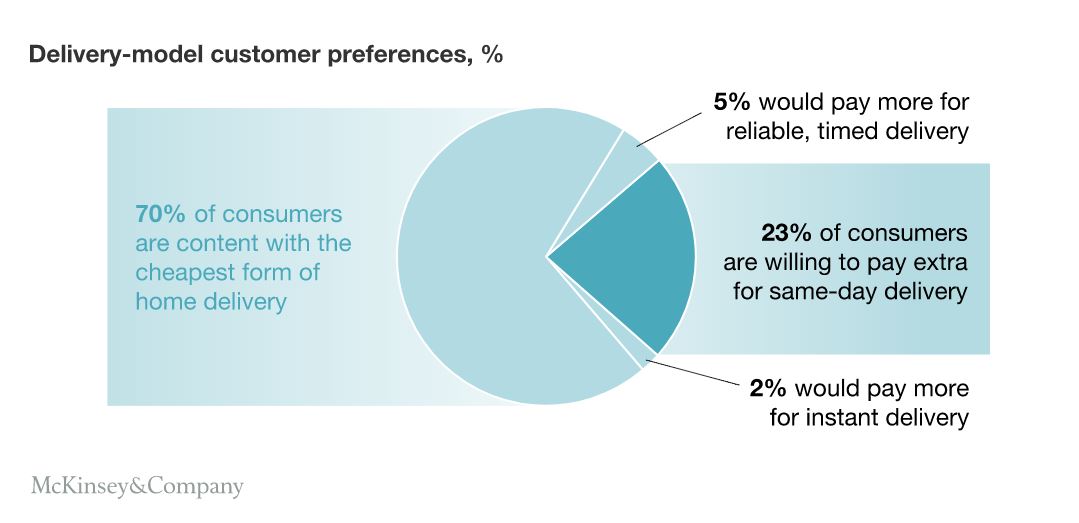In this post, you will learn everything there is to know about the current climate around last mile delivery and logistics, and how to turn the challenges that face the industry into an opportunity for years to come.
It’s hard to have a conversation in the world of commercial transportation and logistics these days without at some point landing on the topic of last mile logistics.
Why?
Because the past decade has seen unprecedented technological innovation among the industry’s larger players, paired with higher and more sophisticated consumer expectations.
Transportation companies, logistics providers and shippers of all sizes need to improve their approach to last mile delivery if they want to snatch up a piece of the skyrocketing demand in an industry witnessing exponential growth.
That starts with an understanding of last mile delivery and logistics, and what the future has in store.
In this post, you will learn everything there is to know about the current climate around last mile delivery and logistics, and how to turn the challenges that face the industry into an opportunity for years to come.
What Is Last Mile Logistics?
It’s pretty intuitive, really.
Last mile logistics is the last step in the delivery process. The process by which an item goes from a distribution center or a facility to the end user.
“Last mile” is obviously a figure of speech, as the delivery can range anywhere from less than a mile to 100 or so miles. Even so, it’s the final step because it puts an item in the hands of the consumer who ordered it.
But the last mile is about more than just getting a product from its second-to-last destination to its final one. It’s an opportunity to create a satisfied consumer.
According to Louis DeJianne, Director of Marketing for Consumer Goods at UPS,
“The final mile delivery when it comes to end consumer delivery is really supplying that end consumer with the experience that they’re looking for.”
As you will learn below, that means a lot more than putting a smile on an Amazon box.
Why Does Last Mile Logistics Matter?
The value of parcels shipped is currently over $83 billion, and the e-commerce market is expected to double in the next 10 years. E-commerce, for the most part, implies that last mile logistics will be involved in the shipping process.
According to Logistics Management, e-commerce sales are expected to hit $2.4 trillion worldwide in 2018. This will logically go hand in hand with a growth in demand for last mile logistics.
Let’s explore why:
Last Mile Logistics: A Unique Yet Imperative Growth Opportunity
Last mile logistics is at the center of a growing global tide:
An ever-increasing consumer desire for on-demand services. In fact, the trend is affecting the transportation and logistics industry more than any other market.
Consumers have shown a willingness to pay a premium for same-day and two day delivery.
Here’s a graph from McKinsey & Company outlining this consumer trend:

Juggernauts in the space, such as Amazon, and established market leaders like UPS and FedEx, have optimized their last mile logistics and delivery solutions, further fueling the fire of demand for immediacy.
To add to the complexity of the marketplace, numerous startups are forming around the world with unique, lean processes aimed at improving the delivery process and getting products to consumers faster and at a lower cost. In fact, in the transportation industry, investments in on-demand companies over the past year are triple the amount of investments made in the previous 4 years combined.
What Does This Mean?
Consumers have learned that they can have fast, efficient delivery at a reasonable cost, so they have no reason to turn back.
This leaves smaller and mid-sized transportation and logistics companies in an interesting situation.
On one hand, they are forced to adapt to growing consumer demand. On the other, they have a unique opportunity to capitalize on unprecedented growth in the industry.
The Challenges Facing Transportation Companies And Logistics Providers
The opportunity to capitalize on exponentially growing demand is often met with a host of challenges.
In the world of last mile logistics, this is no different.
Small to mid-sized companies established in the commercial transportation and logistics industry have the highest potential for growth, as larger companies are leading the charge toward fulfilling consumer demand.
But large companies are not immune to many of the challenges that smaller companies are facing.
Let’s explore some of these challenges:
Cost
When it comes to last mile delivery, cost is the most dominant issue shippers face.
28% of total delivery cost to a transportation and logistics company is accrued in the last mile delivery process.
Given the fact that there are countless other steps in the process, this figure is extremely high.
While the consumer typically covers most of that shipping cost, that’s not always the case. In those situations, the cost of last mile delivery can become crippling for shippers.
So how does this cost build up?
For starters, last mile delivery costs are driven up by a rising demand for expedited delivery.
In addition, the concept of last mile delivery itself caters to a clunky, inefficient delivery process.
According to Supply Chain Dive,
“The largest issue… lies in the cost of transporting individualized shipments to distinct, often unreliable destinations through constantly changing routes.”
The only actionable solution to this—given that demand is only rising—is for companies to improve the efficiency of their logistics and supply chain. This has allowed companies like Amazon to offset costs, and is ultimately the model for success in cost reduction.
Friction and Efficiency
The need to provide excellent customer service throughout the last mile process often adds unexpected wrinkles that decrease efficiency.
This concept is known as friction.
While consumers have shown a greater demand for fast delivery, this goes hand in hand with an increasing demand for communication in the forms of updates and inquiries throughout the delivery process.
Consumers want to know exactly where their parcel is and how it will arrive. They also want to have more say in how it’s delivered (ie. “bring it around to the back door,” or “ring the doorbell when you drop it off”).
While these all seem like minor requests—and they are—they have their part in increasing friction, which decreases shipper efficiency in the last mile.
The best way for transportation and logistics companies to approach this issue is by creating or investing in technologies that allow consumers to communicate with shippers more efficiently.
Transparency
Similar to friction, transparency reflects higher consumer expectations.
It refers to the need for consumers to know where their parcel is at all times and know exactly when it will arrive.
Companies like Uber and Lyft have revolutionized the way consumers interact with transportation-based service providers.
While tracking codes and delivery windows were sufficient a couple years ago, consumers are increasingly seeking greater insight into the order delivery process.
Visibility and transparency have become imperative. If a consumer can look at a map on their smartphone and locate the car that’s coming to pick them up, why can’t they do the same thing for a delivery they’re about to receive?
While these types of technologies are not yet widespread in the world of on-demand parcel delivery, the demand is there, and it will soon become an expectation.
Other Challenges
- Complexity: Not all products can be shipped in a way that the end user expects. Some require assembly, and many shippers do not offer this service. Navigating consumer expectations of product integrity and assembly is becoming increasingly important.
- Capacity: Many shippers simply can’t keep up with the demand. That may seem like a good problem to have, but it can actually be a crippling challenge. This is primarily driven by a shortage of drivers in the industry.
Innovations And Trends In Last Mile Logistics And Delivery
A great deal of technological innovation is accompanying the rise to prominence of last mile logistics.
Many of these developments have been aimed at alleviating the challenges that many shippers continue to face as they seek to accommodate growing demand.
Let’s explore a few major ones:
1. Delivery By Drones, Robots And Self-Driving Cars
This is a long way out from becoming a mainstream phenomenon, but there have been many advancements in creating the technology to make it all possible. In fact, McKinsey envisions a future where drones and autonomous vehicles account for the majority of deliveries.
2. Sensors And Smart Technology
As we mentioned above, consumers want to know where their item is at all times. They also want more detailed information, like the temperature of refrigerated goods in temperature controlled containers, to ensure the integrity of the item they are receiving.
The Internet of Things, along with Blockchain technology are laying the groundwork for implementing these smart sensors on a large scale, while also ensuring data security and accuracy.
3. Urban Warehousing
As demand for same-day delivery increases, companies like Amazon are creating warehouse hubs in more densely populated areas, allowing for faster delivery to more consumers.
While Amazon led the charge on two-hour delivery, urban warehouse hubs are an opportunity many logistics providers or transportation companies should be considering.
The Future Of The Last Mile
The Relationship Between Innovation And Demand Is Interesting:
Consumers are increasingly asking more from the delivery process, which creates a demand for new solutions to meet these expectations.
This acts as a catalyst for new innovations to provide solutions that satisfy everyone involved in the order process–from merchant-to logistics provider-to the end consumer.
The one indisputable fact is that demand and innovation will continue to be interdependent in the commercial transportation and logistics industry for years to come.
And that’s a good thing!
Last mile logistics is at the very center of this demand-driven need for innovation.
Companies in this space are presented with a unique opportunity to rise above their challenges and fulfil consumer expectations by improving their processes, increasing efficiency, and embracing new technology.
